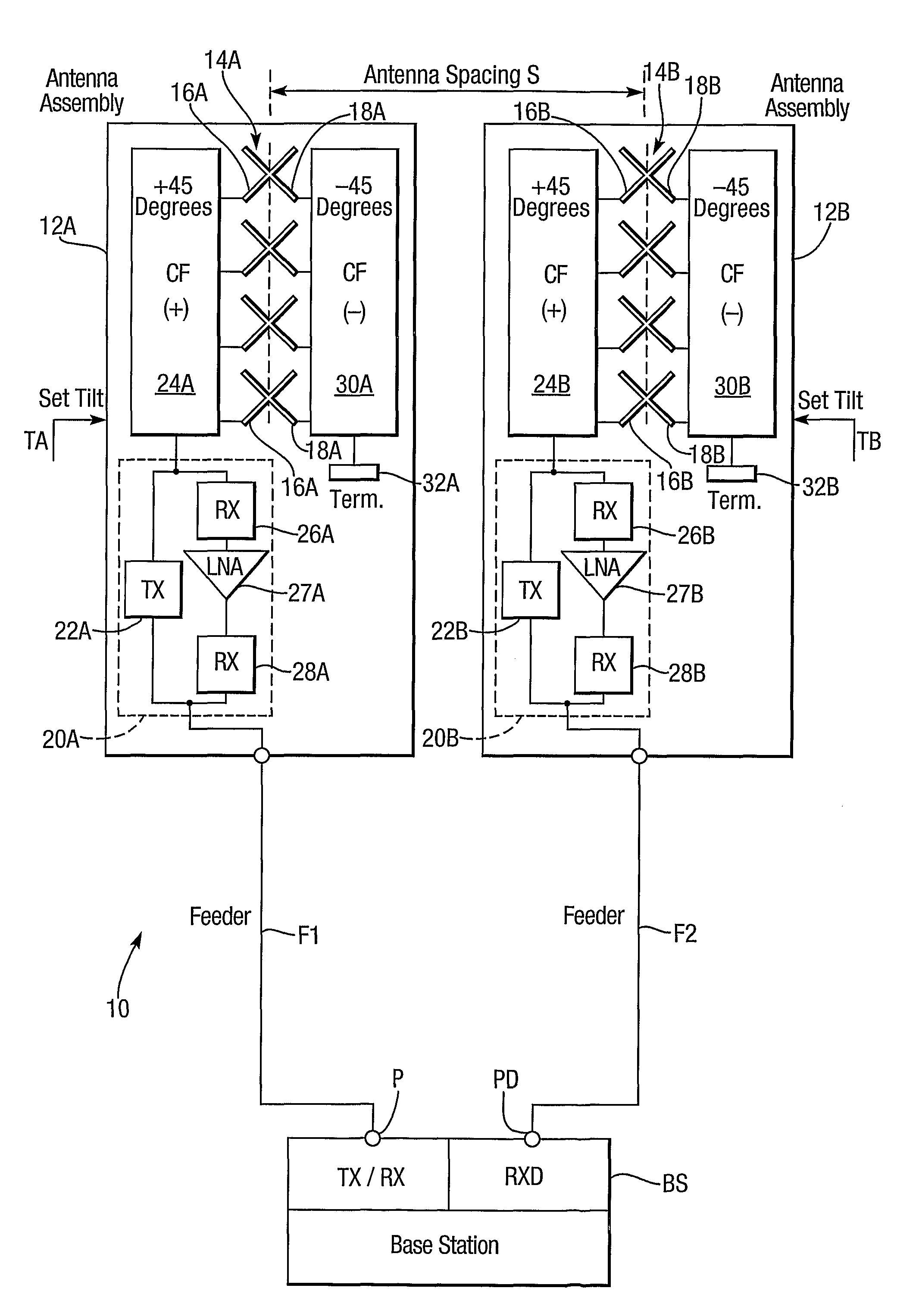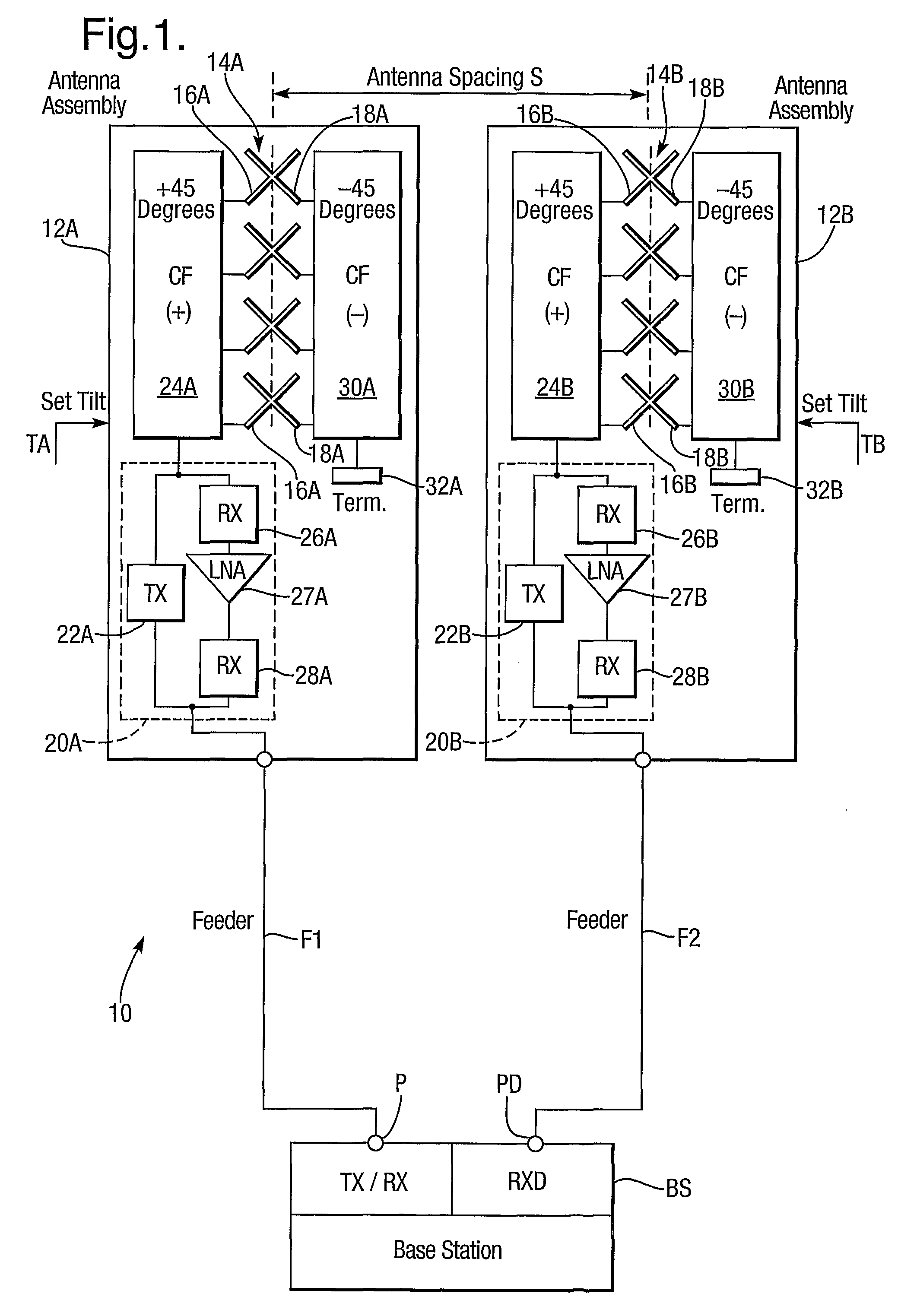Diversity antenna system with electrical tilt
a technology of antenna system and tilt, applied in antennas, polarisation/directional diversity, transmission, etc., can solve the problems of limiting the deployment of new sites, limiting the number of antennas on existing sites, and reducing the visual impact of the environmen
- Summary
- Abstract
- Description
- Claims
- Application Information
AI Technical Summary
Benefits of technology
Problems solved by technology
Method used
Image
Examples
embodiment 140
[0095]The embodiment 140 of the invention described with reference to FIG. 3 has the advantages of the system 40 and in addition the following:[0096](a) the embodiment 140 adds third and fourth transmit signals with different carrier frequencies without requiring to combine signals using filter combiners or 3 dB hybrid combiners;[0097](b) additional transmit signals with different carrier frequencies may be added using filter combiners but without 3 dB hybrid combiners; and[0098](c) the option of transmit space diversity for any of the carrier frequencies is available.
[0099]Further base stations (or carrier frequencies) having contiguous frequencies may be added to the embodiments described with reference to FIGS. 2 and 3 without incurring combining loss in a 3 dB combiner (which is a feature of prior art contiguous frequency combining): this may be implemented using an individual tilt method described in published International Application No. WO 03 / 043127.
[0100]Other embodiments o...
embodiment 240
[0117]Referring now to FIG. 5, there is shown a further antenna system 340 of the invention which is a simplified version of that described with reference to FIG. 4. It is equivalent to the earlier embodiment 240 with the sole exception that the base station filter assembly 250 is replaced by a simplified equivalent comprising a combination of two duplex filters 343A and 343B associated with first and second base stations BS51 and BS52 respectively. It is for use with receive signals having non-contiguous carrier frequencies separable by conventional filters as discussed earlier (its transmit signals need not be non-contiguous). Co-polarisation or anti-polarisation tilt coupling may be implemented as required. Parts equivalent to those described earlier are like referenced—with a prefix 300 replacing 200 where numerically referenced. Description will be directed to aspects of difference between the embodiments 340 and 240.
[0118]The first duplex filter 343A has a narrow band transmit...
embodiment 340
[0120]The embodiment 340 represents a simplification compared to that described with reference to FIG. 4, because it has a reduced number of filters.
[0121]Referring now to FIG. 6, there is shown a further antenna system 440 of the invention with two base stations, i.e. first and second base stations BS61 and BS62, and three feeders F61, F62 and F63; it is suitable for use with contiguous frequencies and co-polarisation or anti-polarisation tilt coupling is available. The antenna system 440 has antenna assemblies 454A and 454B largely as described with reference to FIGS. 3 and 4 for antenna assemblies 254A, 254B, 354A and 354B. The antenna assemblies 454A and 454B of FIG. 6 are equivalent to those of earlier embodiments 240 and 340 with the sole exception that receive signals associated with pairs of corporate feeds 443A, 445A and 443B, 445B in respective antenna stacks 444A and 444B are no longer combined on respective single feeders F61 and F62. Description will be directed to aspe...
PUM
 Login to View More
Login to View More Abstract
Description
Claims
Application Information
 Login to View More
Login to View More - R&D
- Intellectual Property
- Life Sciences
- Materials
- Tech Scout
- Unparalleled Data Quality
- Higher Quality Content
- 60% Fewer Hallucinations
Browse by: Latest US Patents, China's latest patents, Technical Efficacy Thesaurus, Application Domain, Technology Topic, Popular Technical Reports.
© 2025 PatSnap. All rights reserved.Legal|Privacy policy|Modern Slavery Act Transparency Statement|Sitemap|About US| Contact US: help@patsnap.com



